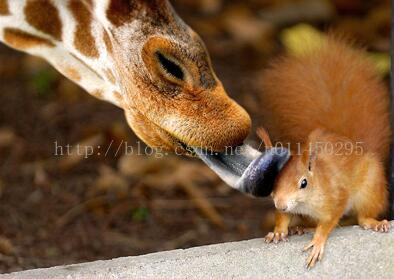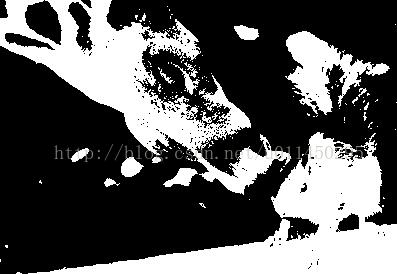溫馨提示×
您好,登錄后才能下訂單哦!
點擊 登錄注冊 即表示同意《億速云用戶服務條款》
您好,登錄后才能下訂單哦!
這篇文章將為大家詳細講解有關C語言如何實現24位彩色圖像二值化,小編覺得挺實用的,因此分享給大家做個參考,希望大家閱讀完這篇文章后可以有所收獲。
具體內容如下
// huiduhua.cpp : 定義控制臺應用程序的入口點。
//
#include "stdafx.h"
#include<stdio.h>
#include<windows.h>
int _tmain(int argc, _TCHAR* argv[])
{
BITMAPFILEHEADER bfhead;
BITMAPINFOHEADER bihead;
RGBQUAD *pColorTable;
unsigned char *pBmpBuf;
FILE *fp1=fopen("鼠.bmp","rb");
if(fp1==0)
return 0;
fread(&bfhead,14,1,fp1); //將文件頭讀入內存
fread(&bihead,40,1,fp1); //將信息頭讀入內存
int LineByte=(bihead.biWidth*24/8+3)/4*4; //保證每行字節數為4的整數倍
pBmpBuf=new unsigned char[LineByte*bihead.biHeight]; //為數據區分配內存空間
fread(pBmpBuf,LineByte*bihead.biHeight,1,fp1); //將bmp數據區讀入內存
fclose(fp1);
printf("Width:%d, Height: %d,biBitCount:%d\n",bihead.biWidth,bihead.biHeight,bihead.biBitCount);
//現將真彩圖灰度化
int LineByte1=(bihead.biWidth*8/8+3)/4*4; //由于灰度化后每像素位數變為8,所以每行字節數發生改變,但仍要求為4的整數倍
FILE *fp2=fopen("鼠2.bmp","wb");
if(fp2==0)
return 0;
//更改文件頭,并將其保存
bfhead.bfSize=14+40+sizeof(RGBQUAD)*256+LineByte1*bihead.biHeight; //更改文件大小
bfhead.bfOffBits=14+40+sizeof(RGBQUAD)*256; //更改偏移值
fwrite(&bfhead,14,1,fp2);
//更改信息頭并將其保存
bihead.biBitCount=8; //更改每像素位數
bihead.biSizeImage=LineByte1*bihead.biHeight; //更改數據區大小
fwrite(&bihead,40,1,fp2);
//因為灰度化圖像有顏色表,所以創建顏色表并保存
pColorTable=new RGBQUAD[256];
for(int i=0;i<256;i++)
pColorTable[i].rgbRed = pColorTable[i].rgbGreen = pColorTable[i].rgbBlue = i;//使顏色表中每種顏色的R,G,B分量相等且等于索引值
fwrite(pColorTable,sizeof(RGBQUAD),256,fp2);
//改變數據區
unsigned char *pBmpBuf1;
pBmpBuf1=new unsigned char[LineByte1*bihead.biHeight];
for(int i=0;i<bihead.biHeight;i++)
for(int j=0;j<bihead.biWidth;j++)
{
unsigned char *pb1,*pb2;
pb1=pBmpBuf+i*LineByte+j*3;
int y=*(pb1)*0.299+*(pb1+1)*0.587+*(pb1+2)*0.114;
pb2=pBmpBuf1+i*LineByte1+j;
*pb2=y;
}
//二值化方法一:閾值設為127,灰度值小于127的置零,其他的置為255;
//for(int i=0;i<bihead.biHeight;i++)
// for(int j=0;j<bihead.biWidth;j++)
// {
// unsigned char *pb;
// pb=pBmpBuf1+i*LineByte1+j;
// if(*pb<127) //將每個像素值與127比較
// *pb=0;
// else
// *pb=255;
// }
//方法二:計算像素的平均值K,掃描圖像的每個像素值如像素值大于K像素值設為255(白色),值小于等于K像素值設為0(黑色)
int y=0;//像素和
int k=0;//像素個數
for(int i=0;i<bihead.biHeight;i++)
for(int j=0;j<bihead.biWidth;j++)
{
unsigned char *pb;
pb=pBmpBuf1+i*LineByte1+j;
y=y+*pb; //計算所有像素灰度值之和
k++; //統計像素個數
}
y=y/k; //求像素平均值
for(int i=0;i<bihead.biHeight;i++)
for(int j=0;j<bihead.biWidth;j++)
{
unsigned char *pb1;
pb1=pBmpBuf1+i*LineByte1+j;
if(*pb1<y) //將每個像素值與平均值作比較
*pb1=0;
else
*pb1=255;
}
fwrite(pBmpBuf1,LineByte1*bihead.biHeight,1,fp2);
fclose(fp2);
system("pause");
return 0;
}

關于“C語言如何實現24位彩色圖像二值化”這篇文章就分享到這里了,希望以上內容可以對大家有一定的幫助,使各位可以學到更多知識,如果覺得文章不錯,請把它分享出去讓更多的人看到。
免責聲明:本站發布的內容(圖片、視頻和文字)以原創、轉載和分享為主,文章觀點不代表本網站立場,如果涉及侵權請聯系站長郵箱:is@yisu.com進行舉報,并提供相關證據,一經查實,將立刻刪除涉嫌侵權內容。